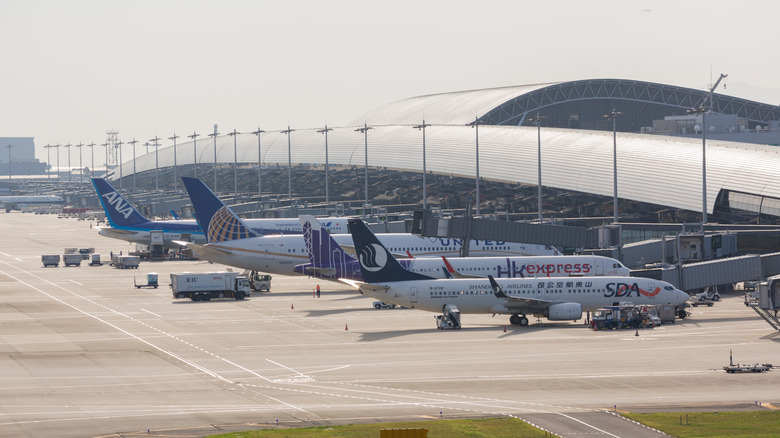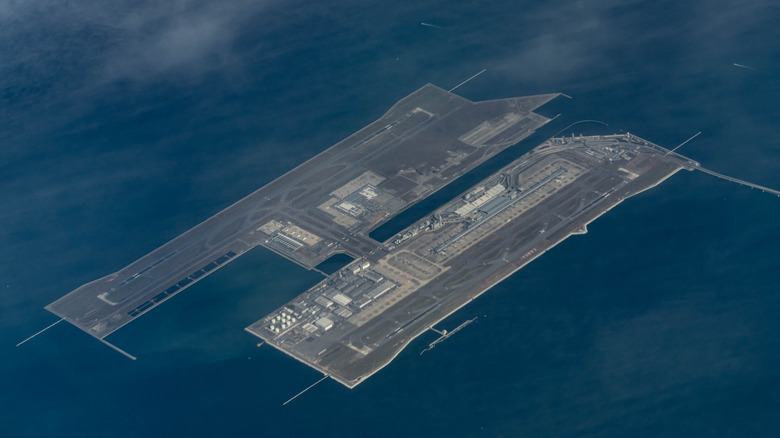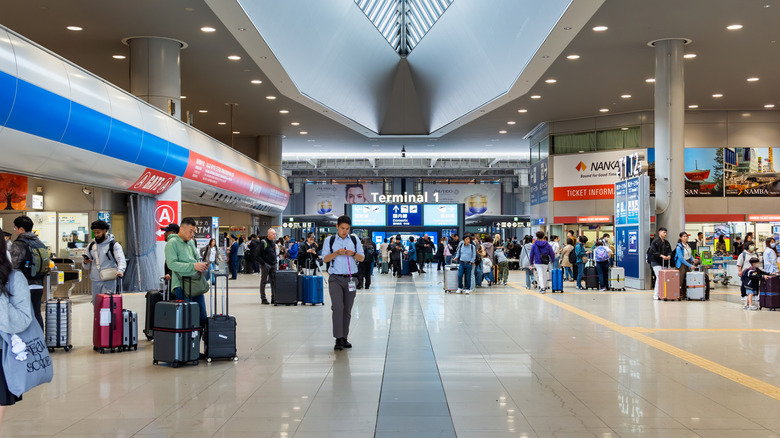Is Kansai Floating Airport Really Sinking? (And Are There Plans To Fix It?)
Kansai International Airport (ICAO code RJBB) represents a true engineering marvel born out of necessity. Because the Osaka Bay area is so densely packed with attractions like Super Nintendo World and houses major corporations like Panasonic, this requires a robust, modern airport that could keep up with demand. With the older Itami Airport facing rampant overcrowding and virtually no space available for a large-scale international airport on land (Osaka Bay is surrounded by hills on three sides), the Kansai prefecture opted for an unorthodox approach: building the world's first truly floating airport — an airport that's now sinking.
This phenomenon is the result of the alluvial clay resting beneath the island's foundation. For context, an alluvial deposit refers to sediment deposited on the seabed by systems like rivers and streams. These bring in fresh soil via flooding or tidal forces, forming highly stratified beds composed of minerals picked up by the parent water source. In Osaka Bay's case, this resulted in layers of loose clay that the airport continuously sinks into, its weight effectively acting like a massive press.
The Japanese government is pouring considerable resources to mitigating this issue in ongoing projects involving concrete foundations, raising the airport's seawall, and installing specialized hydraulic jacks; as a result, as of 2024, the airport fell only 6 centimeters (2.36 inches) annually, versus 19 inches when it first opened.
A sinking foundation
Engineers constructed the artificial island using a piece of equipment known as a sand drain. Because the island's foundation is comprised of layers of loosely-packed clay at the sea floor, excessive weight placed on top would inevitably force the water out through the gaps and compress the layers together. To solve this problem, engineers installed one million drains, 20 meters long and 40 centimeters in diameter, driven into the seabed to allow the trapped water to travel through the pipes This effectively compressed the clay by two-thirds during the island's construction.
Unfortunately, planners underestimated the magnitude of the issue. While the top-most layers of clay were successfully drained, the deeper clay strata proved more unpredictable and contained additional pockets. These represent the main ongoing engineering challenge behind the airport's dilemma, and a massive financial burden, to the tune of tens of billions of US dollars invested by the governments of Japan and the United States.
The main logistical reason behind spending so much money relies on a lack of alternatives. Along with Itami Airport, Kansai International Airport serves the cities of Osaka, Kyoto, and Kobe. Currently, it's Japan's third-busiest airport, behind Tokyo's Haneda and Narita, respectively, and sees approximately 30.6 million passengers yearly as of 2024 via airlines like All Nippon Airways (which occasionally field aircraft with interesting liveries). This volume is why Kansai was constructed to begin with, and there's no space for such an airport anywhere in Osaka Bay without great expense (hence the original decision to build it over water), so engineers face no choice but to continuously mitigate the ongoing issue.
How engineers are tackling Kansai's unique challenges
The main reason why Kansai International Airport remains continuously sinking today has to do with what's underneath the already-treated topmost layers of clay. Approximately 70 percent of those topmost layers are water, whereas the lower layers are more solid, being about 40 percent water. This lower layer, called the pleistocene layer (as opposed to the top holocene layer), is so thick that existing soil modification techniques don't work on it. As such, this soil will naturally settle over time, compressing under the weight of the airport itself. Because this layer represents the near entirety of the airport's issues, and likewise cannot be directly addressed, engineers instead observe and mitigate its various symptoms.
Because of the inherent risks of rainfall and tidal forces, the airport boasts a number of advanced features to combat overwash and rainwater, such as drainage pipes capable of handling up to 55mm of rainwater per hour. The rock bed upon which it's constructed also helps mitigate rushing tides, and it features a specialized seawall designed to combat the area's frequent extreme occurrences like typhoons.
However, none of these directly address the ground settling unevenly. Engineers also accounted for this phenomenon, placing the entire airport on a concrete foundation to ensure it settles as evenly as possible. The aforementioned jacks can also raise specific sections or buildings as needed to keep it as level as possible. This concrete construction also helps mitigate against earthquakes, another commonality in the region. Despite these measures, the sinking will unfortunately continue, with some portions projected to fall below sea level by 2056 according to current estimates.


